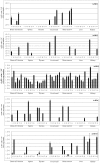Identification, expression and activity analyses of five novel duck beta-defensins
- PMID: 23112840
- PMCID: PMC3480435
- DOI: 10.1371/journal.pone.0047743
Identification, expression and activity analyses of five novel duck beta-defensins
Erratum in
- PLoS One. 2013;8(4). doi: 10.1371/annotation/8e3de33f-aaad-4c55-a21e-1677fe496f68
Abstract
In the current study, five novel avian β-defensins (AvBDs) were identified and characterized in tissues from Peking ducks (Anas platyrhynchos). The nucleotide sequences of these cDNAs comprised 198 bp, 182 bp, 201 bp, 204 bp, and 168 bp, and encoded 65, 60, 66, 67, and 55 amino acids, respectively. Homology, characterization and comparison of these genes with AvBD from other avian species confirmed that they were Apl_AvBD1, 3, 5, 6, and 16. Recombinant AvBDs were produced and purified by expressing these genes in Escherichia coli. In addition, peptides were synthesized according to the respective AvBD sequences. Investigation of the antibacterial activity of the Apl_AvBDs showed that all of them exhibited antibacterial activity against all 12 bacteria investigated (P<0.05 or P<0.01). In addition, the antibacterial activity of all of the AvBDs against M. tetragenus and P. multocida decreased significantly in the presence of 150 mM NaCl (P<0.01). None of the AvBDs showed hemolytic activity. Consistent with their broad-spectrum antibacterial activity, the five novel Apl_AvBDs inhibited replication of duck hepatitis virus (DHV) in vitro significantly (P<0.05). The mRNA expression of all five Apl_AvBD in most tissues, including immune organs and the liver, was upregulated in response to DHV infection at different time points. These findings provide evidence that these defensins activate the immune response to combat microbial infection.
Conflict of interest statement
Figures







Similar articles
-
Three novel Anas platyrhynchos avian β-defensins, upregulated by duck hepatitis virus, with antibacterial and antiviral activities.Mol Immunol. 2011 Oct;49(1-2):84-96. doi: 10.1016/j.molimm.2011.07.019. Mol Immunol. 2011. PMID: 21856003
-
Structure-function analysis of Avian β-defensin-6 and β-defensin-12: role of charge and disulfide bridges.BMC Microbiol. 2016 Sep 9;16(1):210. doi: 10.1186/s12866-016-0828-y. BMC Microbiol. 2016. PMID: 27613063 Free PMC article.
-
Discovery of Anas platyrhynchos avian beta-defensin 2 (Apl_AvBD2) with antibacterial and chemotactic functions.Mol Immunol. 2009 Jun;46(10):2029-38. doi: 10.1016/j.molimm.2009.03.003. Epub 2009 Apr 11. Mol Immunol. 2009. PMID: 19362739
-
Avian β-defensins expression for the innate immune system in hen reproductive organs.Poult Sci. 2015 Apr;94(4):804-9. doi: 10.3382/ps/peu021. Epub 2015 Feb 13. Poult Sci. 2015. PMID: 25681610 Review.
-
[Overview on duck virus hepatitis A].Sheng Wu Gong Cheng Xue Bao. 2012 Jul;28(7):789-99. Sheng Wu Gong Cheng Xue Bao. 2012. PMID: 23167191 Review. Chinese.
Cited by
-
Avian antimicrobial host defense peptides: from biology to therapeutic applications.Pharmaceuticals (Basel). 2014 Feb 27;7(3):220-47. doi: 10.3390/ph7030220. Pharmaceuticals (Basel). 2014. PMID: 24583933 Free PMC article.
-
Pathogenicity and innate immune responses induced by fowl adenovirus serotype 8b in specific pathogen-free chicken.Poult Sci. 2023 Aug;102(8):102846. doi: 10.1016/j.psj.2023.102846. Epub 2023 Jun 5. Poult Sci. 2023. PMID: 37354616 Free PMC article.
-
Differential modulation of avian β-defensin and Toll-like receptor expression in chickens infected with infectious bronchitis virus.Appl Microbiol Biotechnol. 2015 Nov;99(21):9011-24. doi: 10.1007/s00253-015-6786-8. Epub 2015 Jul 4. Appl Microbiol Biotechnol. 2015. PMID: 26142390 Free PMC article.
-
Comparative analysis of early immune responses induced by two strains of Newcastle disease virus in chickens.Microbiologyopen. 2019 Apr;8(4):e00701. doi: 10.1002/mbo3.701. Epub 2018 Aug 1. Microbiologyopen. 2019. PMID: 30070070 Free PMC article.
-
Induction of Avian β-Defensin 2 Is Possibly Mediated by the p38 MAPK Signal Pathway in Chicken Embryo Fibroblasts After Newcastle Disease Virus Infection.Front Microbiol. 2018 Apr 19;9:751. doi: 10.3389/fmicb.2018.00751. eCollection 2018. Front Microbiol. 2018. PMID: 29725321 Free PMC article.
References
-
- White DG, Zhao S, Sudler R, Ayers S, Fredman S, et al. (2001) The isolation of antibiotic-resistant salmonella from retail groud meats. N Engl J Med 345: 1147–1154. - PubMed
-
- Zasloff M (2002) Antimicrobial peptides of multicellular organisms. Nature 415: 389–395. - PubMed
-
- Brogden KA, Ackermann M, McCray Jr PB, Tack BF (2003) Antimicrobial peptides in animals and their role in host defences. Int J Antimicrob Agents 22: 465–478. - PubMed
-
- Ganz T (2005) Defensins and other antimicrobial peptides: a historical perspective and an update. Comb Chem High Throughput Screening 8: 209–217. - PubMed
Publication types
MeSH terms
Substances
LinkOut - more resources
Full Text Sources

